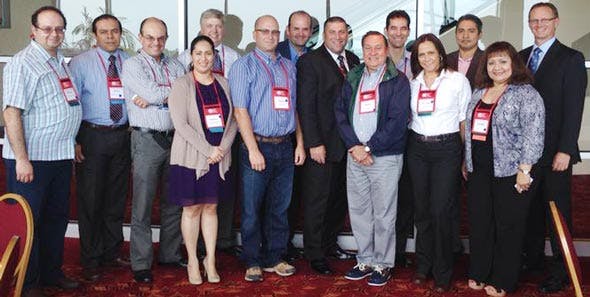USMEF Leads Mexican Team to Meat Research Conference
A team of Mexican meat scientists representing government agencies, leading food companies and food industry specialists, led by technical experts from USMEF, was among the attendees at the five-day American Meat Science Association’s 2014 Reciprocal Meat Conference (RMC) that annually brings together meat scientists, regulators and academics from throughout the Americas to examine food production and safety-related issues.

Mexican meat scientists, led by Dr. Nelson Huerta of USMEF (front, 3rd from r.), attend the Reciprocal Meat Conference
The Pork Checkoff and Beef Checkoff Program were among the many funding sources for the event that drew more than 800 attendees to the University of Wisconsin at Madison.
Members of Mexico’s National Service of Health, Food Safety and Agro-Alimentary Quality (SENASICA) were joined by representatives of the Mexican Meat Council, AMEXITEC (Mexican Association of Meat Science) and leading Mexican food industry corporations Sigma Alimentos and Grupo Bafar, in addition to Dr. Nelson Huerta, director of technical services for USMEF-Latin America, and Alejandra Valdez, USMEF-Mexico technical manager. Paul Clayton, USMEF’s senior vice president of export services, also participated in the programs.
The annual RMC meetings provide a venue for discussing issues and challenges that involve food production technologies. Industry counterparts from across the continent share knowledge and best practices to ensure that food products are produced and transported based on parallel systems.
“We know that SAGARPA (Mexico’s Secretariat of Agriculture, Livestock, Rural Development, Fisheries and Food) is strongly interested in receiving assistance from the USDA in designing a harmonized beef carcass grading system,” said Huerta. “To that end, SENASICA officers were able to get an update on the USDA beef grading system and U.S. production technologies.”
Huerta noted that an important element of the meetings is ensuring that import and export requirements are synchronized between government agencies to facilitate the smooth transit of food products that have a finite lifespan.
“The time also was well-spent as the Mexican team took advantage of the opportunities the meeting offered to focus on MRL (maximum residue limit) requirements and food safety policies, including audits of U.S. meat establishments required for U.S. products to be eligible for export to Mexico,” said Huerta, who also serves as president of AMEXITEC.
“Attending the RMC is a great opportunity to learn about new technology and research that impact meat processing and marketing,” said Clayton. “Mexico is a large market for U.S. meat products and I hope our guests found this information valuable and can apply it in their market.”
The RMC covered a wide spectrum of topics ranging from antibiotic resistance and a historical perspective of controlling pathogens to “The Future of Pork Quality” and research on beef carcass maturity and palatability.
